 Grand Theft Auto III marked a groundbreaking shift in the action/adventure genre of video games. A little over a decade ago, the popular shoot-em-up title burst onto the scene, and gamers received an experience of organized crime and unbridled mayhem akin to a sizzling Hollywood blockbuster. Recently, Rockstar Games released a port of GTA III for iOS and select Android devices in celebration of the game’s 10th anniversary. Does the epic Liberty City saga of violence and revenge translate to mobile devices? Let’s find out!
Grand Theft Auto III marked a groundbreaking shift in the action/adventure genre of video games. A little over a decade ago, the popular shoot-em-up title burst onto the scene, and gamers received an experience of organized crime and unbridled mayhem akin to a sizzling Hollywood blockbuster. Recently, Rockstar Games released a port of GTA III for iOS and select Android devices in celebration of the game’s 10th anniversary. Does the epic Liberty City saga of violence and revenge translate to mobile devices? Let’s find out!
First Run
There are twenty Android devices which are currently capable of running Grand Theft Auto III: 10 Year Anniversary Edition:- Acer Iconia
- Asus Eee Pad Transformer
- Dell Streak 7
- Galaxy Nexus
- HTC Rezound
- LG Optimus 2x
- LG Optimus Pad
- Motorola Atrix 4G
- Motorola Droid Bionic
- Motorola Droid X2
- Motorola Photon 4G
- Motorola Xoom
- Samsung Galaxy R
- Samsung Galaxy S II
- Samsung Galaxy Tab 8.9
- Samsung Galaxy Tab 10.1
- Sony Ericsson Xperia Play
- Sony Tablet S
- T-Mobile G2x
- Toshiba Thrive
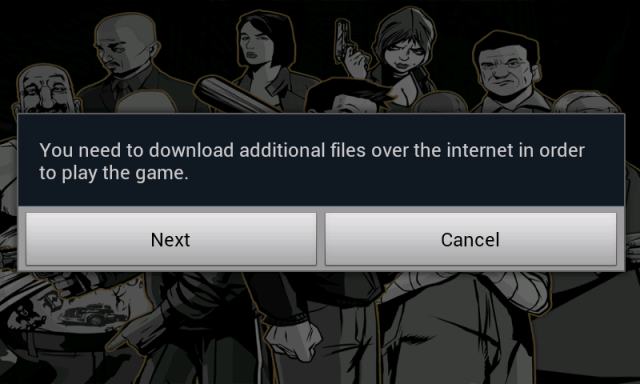

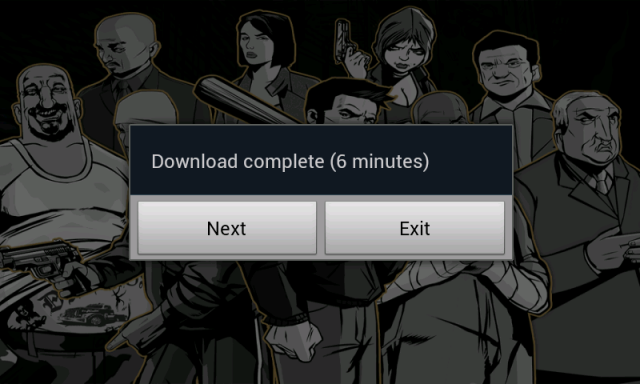
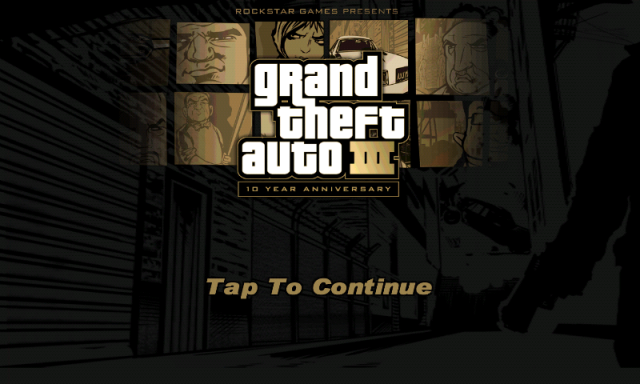
Home Screen and Options
As you can see from the home screen, you have three selections to choose from: Start Game, Options, and Quit Game. While you may be tempted to jump straight in and begin cruising the streets and assaulting civilians, spend a little time in the Options section first. Even though the game is a faithful port from the PS2 classic, the interface has changed to accommodate touch screen devices.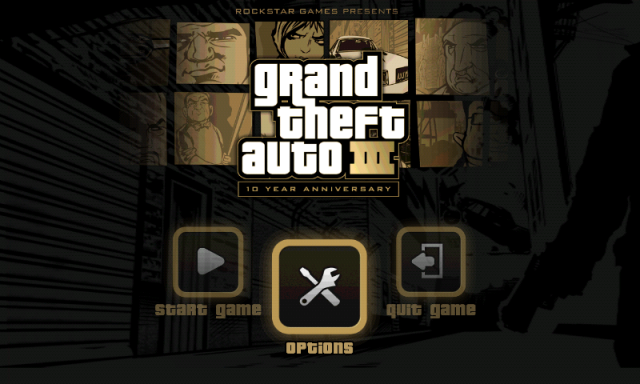
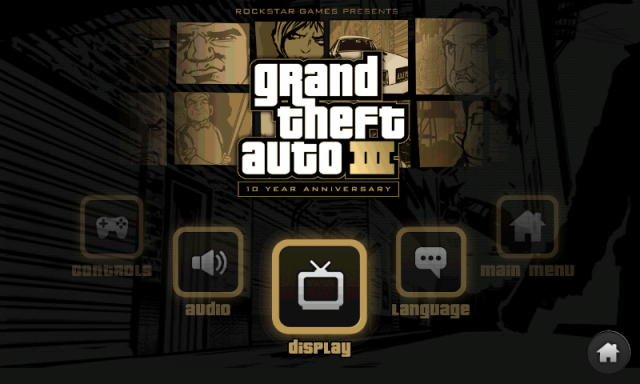
The Options section includes five selections: Controls, Audio, Display, Language, and Main Menu. The Controls screen includes options for adjusting the camera view and re-positioning and re-sizing the touchscreen controls. (The latest version of the game supports Bluetooth controllers as well, including the Gamestop Wireless Game Controller.) I would highly recommend checking out the View Controls link because it contains a handy legend of all the touchscreen icons.
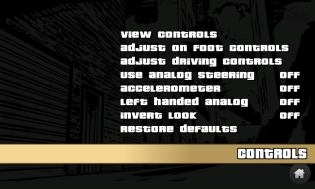
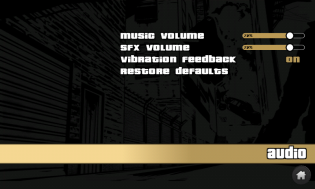
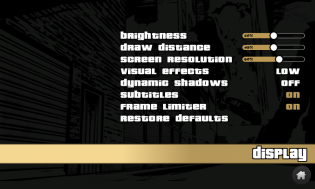

The Audio section includes a page for adjusting the volume of music and sound effects, and you can toggle vibration feedback. The Display section lets you adjust the brightness, screen resolution, subtitles, and other visual effects of the game. Depending on your device’s processor, you may want to edit these settings to give you a smoother gameplay experience. The Language section gives you six different language options (English, French, German, Italian, Spanish, Japanese), and the Main Menu button takes you back to the home screen. When you have your options fully configured, now you’re ready to play.
Gameplay
Even though this is a mobile port of the Playstation 2 game, none of the sounds or graphics are compromised. Full-motion cutscenes include spoken audio, and the user can choose from several radio stations while driving through the streets of Liberty City. Whether you’re playing on a phone or on a tablet, you’re getting the full GTA III experience. Newbies and seasoned veterans alike will delight in the urban, freestyle gaming environment, the array of different vehicles, the colorful Liberty City residents, and dozens of crime missions throughout the game. There’s no shortage of tasks to complete in the game, even if you just want to wreak havoc and go on a wild police chase.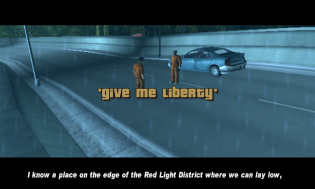

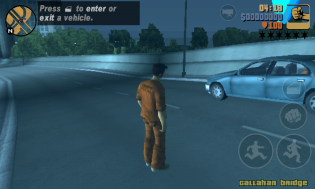
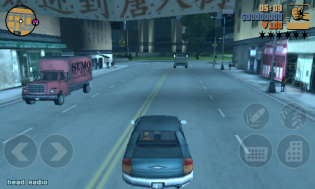
Drawbacks
Perhaps the most major drawback of the game is the touchscreen controls. This is a pretty big issue considering the port is aimed for touchscreen devices. If you think about how the game works on Playstation 2, your controller has sixteen buttons (the D-pad, start, select, circle, triangle, square, X, L1, L2, R1, R2, and the analog stick buttons). Now imagine if all those controls were mapped onto a touchscreen device through a series of taps and swipes. When you’re in the middle of some fast-paced action like a car chase, or even through mundane movements like walking through the street or driving between missions, your controls are only as good as your speed in tapping and swiping. And sometimes, even that isn’t responsive enough. Controlling the main character’s movement is done through a virtual joystick that appears on the left side of the screen whenever you tap your thumb. Then there are buttons on the right for running, jumping, punching or shooting, entering a car, and changing your camera angle. These controls change once you enter a car, as you now have buttons for accelerating, braking, honking the horn, getting out of the car. And if you’ve played GTA III before, you know that driving is still pretty finicky. The pressure sensitivity of driving with a controller is lost through the touchscreen controls. You also have the option of turning on your device’s accelerometer to steer once you’re driving (this is in the Options screen, but this makes driving and seeing where you’re going even worse. Unless you’re playing with a Bluetooth controller, traversing around Liberty City will quickly become an exercise in patience.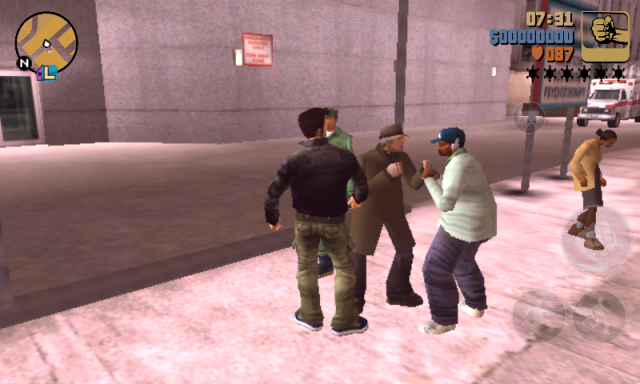
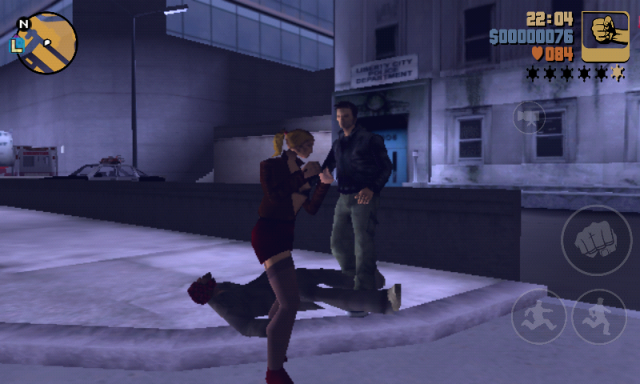
Fighting and shooting in the game are equally problematic because of the controls. For fighting, you have to make sure you are facing your opponent, which can be difficult with the touch controls. Your opponent, on the other hand, will often be more nimble in getting around you than you are with adjusting the camera. If you happen to get in a brawl with several opponents, running away is your best option if you want to survive. When shooting, the game has an automatic aiming feature which will target anyone in your shooting radius based on their proximity to you. Of course, this means you’ll end up tagging innocent bystanders while your opponent fires away at you with no obstacles. The other drawback I discovered deals with ending your game. The game has autosave functionality, but if you exit the game by pressing the Home or Back button, it will still run in the background. In order to properly quit the game, you’ll need to navigate to the game’s home screen and click the Quit Game button. While I appreciate that the game posts a notification letting you know it’s waiting for you to return, the option to quit the game from the Notifications drawer would have been nice as well. A few quick plays throughout the day will easily run your device’s battery down to critical levels.
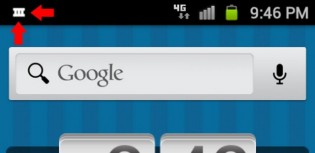
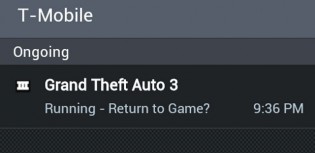
Conclusion
Grand Theft Auto III: 10 Year Anniversary Edition brings you everything you love about the Grand Theft Auto series — open, destructible gameplay, civil disorder, and unbridled pandemonium on a city-wide scale. All the music and characters you know and love are back for the ride, and it’s a great trip down memory lane for hardcore gamers. However, the lack of finesse with touchscreen controls makes enjoying gameplay more of a hassle than a treat. For optimal performance, make sure you have a Bluetooth controller to circumvent this issue. Grand Theft Auto III: 10 Year Anniversary Edition is available on the Android Market for $4.99 and requires select Android devices running Android OS v2.2 or higher to run. Download the app from the Market link below or by using the QR code provided.
Download Grand Theft Auto III: 10 Year Anniversary Edition
Grand Theft Auto III: 10 Year Anniversary Edition is available on the Android Market for $4.99 and requires select Android devices running Android OS v2.2 or higher to run. Download the app from the Market link below or by using the QR code provided.
Download Grand Theft Auto III: 10 Year Anniversary Edition
Frequently Asked Questions about Grand Theft Auto III: 10 Year Anniversary Edition
What are the unique features of Grand Theft Auto III: 10 Year Anniversary Edition?
The 10 Year Anniversary Edition of Grand Theft Auto III comes with several unique features that set it apart from the original version. These include updated graphics and character models, a custom soundtrack option, and a new touch screen interface for easier navigation. The game also includes all the original missions, characters, and storyline from the original game, providing a nostalgic experience for long-time fans of the series.
Is the game compatible with all mobile devices?
Grand Theft Auto III: 10 Year Anniversary Edition is compatible with a wide range of mobile devices. However, it’s always best to check the specific requirements for your device before downloading the game. The game is optimized for both Android and iOS devices.
How does the touch screen interface work in the game?
The touch screen interface in Grand Theft Auto III: 10 Year Anniversary Edition has been designed to make the game more accessible for mobile users. It includes customizable controls, allowing players to adjust the layout and sensitivity to their liking. The interface also includes a virtual joystick for movement and context-sensitive buttons that change depending on the in-game situation.
Can I play the game offline?
Yes, Grand Theft Auto III: 10 Year Anniversary Edition can be played offline. Once the game is downloaded and installed on your device, you do not need an internet connection to play.
What is the storyline of Grand Theft Auto III: 10 Year Anniversary Edition?
The storyline of Grand Theft Auto III: 10 Year Anniversary Edition follows the same plot as the original game. Players take on the role of a criminal in Liberty City, completing missions for various crime syndicates while trying to rise through the ranks of the criminal underworld.
Are there any in-app purchases in the game?
Grand Theft Auto III: 10 Year Anniversary Edition is a paid game, and once purchased, all content is available to the player. There are no additional in-app purchases required to access any part of the game.
How does the custom soundtrack option work?
The custom soundtrack option in Grand Theft Auto III: 10 Year Anniversary Edition allows players to create their own in-game radio station using music files stored on their device. This feature adds a personal touch to the gaming experience.
Is the game available in multiple languages?
Yes, Grand Theft Auto III: 10 Year Anniversary Edition is available in multiple languages. The game supports English, French, Italian, German, Spanish, and Japanese.
Can I save my game progress?
Yes, Grand Theft Auto III: 10 Year Anniversary Edition allows players to save their game progress. The game features an auto-save function, and players can also manually save their progress at any time during the game.
Are there any parental controls in the game?
Grand Theft Auto III: 10 Year Anniversary Edition does not have built-in parental controls. However, the game is rated for mature audiences due to its violent content and mature themes. It’s recommended that parents review the game’s content before allowing younger players to play.
Maurice Cherry is a web entrepreneur, freelance technology journalist, and technology consultant for non-profit organizations and politicians. He is best known as the creator of the Black Weblog Awards, the world’s premier event for showcasing bloggers, podcasters, and video bloggers of the African diaspora. Maurice is also Creative Principal at 3eighteen media and an adjunct professor with DeVry University. Maurice is an honors graduate of Morehouse College, and currently lives in Atlanta, GA.



